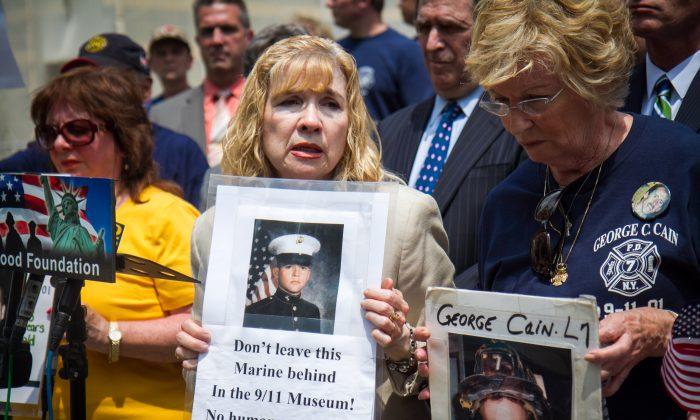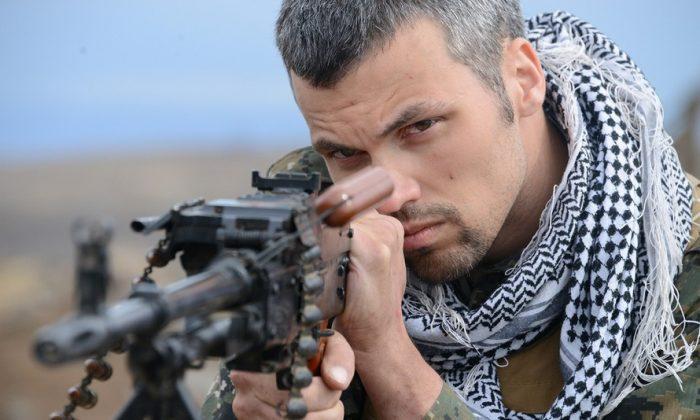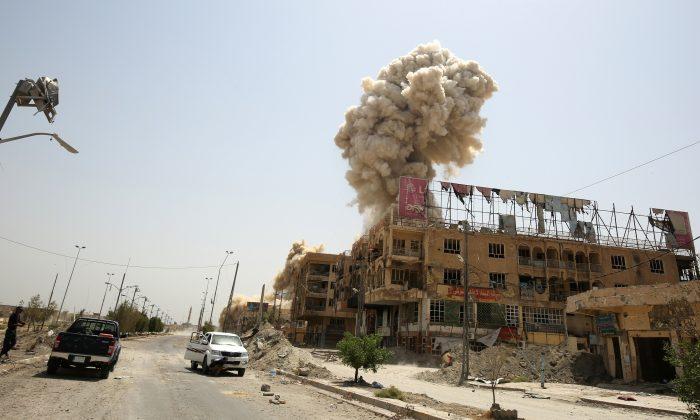NEW YORK—The first days of public access to the National September 11 Memorial & Museum have been marked by controversies and disagreements. A dispute among family members of Sept. 11 victims over the repository of remains kept at bedrock has been particularly poignant.
The five-level museum, which extends underground to bedrock level of the original buildings, is a somber testament to a day of horror for the world and the aftermath that followed. The memorial fountains, too, are a moving tribute. There, the names of almost 3,000 people are etched in bronze parapets that circumvent the massive, overwhelming water that disappears into the ground. The names include everyone who died in the Sept. 11 terrorist attacks at the World Trade Center complex, in Pennsylvania, and Washington, D.C., as well as the 1993 World Trade Center terrorist bombing that killed six people.
The names of the dead echo throughout the entire 8-acre site, both above and belowground. Now, some of the loved ones left behind are struggling with whether decisions made that led to an underground repository truly honor the dead.
Repository of Remains
Nowhere is the importance of honoring more symbolic, hallowed, or controversial than behind a massive blue-paneled wall at bedrock level. There, between the footprints of the former twin towers, is a repository that holds the approximately 14,000 remains of Sept. 11 victims. Of those, about 8,000 are still unidentified.
The remains are under the protection and safekeeping of the New York City Office of the Chief Medical Examiner (OCME), which guards the repository. According to Julie Bolcer, director of public affairs for the OCME, staff continues to work toward identification. Advances in DNA testing technology mean that at any time a family could find out that their loved one has been found. Once identified, the remains can be claimed, but so far, family members have chosen to leave at least 6,000 remains in the repository that one family member said feels like a “funeral home.”
“The truth is, we’re the ones who asked for it,” said Charles G. Wolf on Wednesday. Wolf’s wife, Katherine, died on Sept. 11 and her remains have never been identified. Though he’s not officially affiliated with any one of a number of Sept. 11 family organizations, Wolf has been active over the past 13 years in advocating for various causes related to Sept. 11 victims and survivors. Most recently, that’s been the growing controversy and confusion over the repository.
“Families were waiting for this to happen,” said Wolf, referring to the several years the remains were kept by the OCME in a makeshift chapel near the East River, and then at an OCME office in Manhattan after Sandy flooded the chapel area. “This is all carefully, carefully planned.”
Wolf describes the repository, which he has visited, as a room with a two-seat couch, coffee table, and registration book. From the room, you can look through a viewing window and see 8-foot-high cabinets arranged in four rows that by his estimate run about 70-80 feet long.
“The way they did it—that was better than I could have expected,” said Wolf.
The OCME declined to discuss the details of the repository or the manner in which the remains are stored. Family members familiar with it said that the remains are kept in medical examiner field bags inside the repository drawers, in a climate-controlled environment necessary to preserve their integrity for future analysis. They also said the OCME continues to examine and test the remains as DNA technology advances, enabling matches with victims still listed as missing.
Hard to Reconcile
For some who lost family members on Sept. 11, though, they see the location of the remains as a slap in the face.
Just days after the museum opened to the public, on May 28, a group called 9/11 Parents and Families of Firefighters and World Trade Center Victims rallied to have the remains moved to higher ground. The organization claims to have a few hundred members, but others suggest that number is much lower.
Sally Regenhard, who heads the group, has been involved with 9/11 family advocacy from early on and was part of the 9/11 Coalition of Families, an umbrella group. Her son Christian, a 28-year-old firefighter, was killed on Sept. 11 and his remains have never been found. She said that from early on the general consensus and focus was to have family members’ remains with the memorial.
“Everything we did in those early days was planning for a memorial, not a museum,” said Regenhard on Wednesday. “We had to spend all our time having a [plan for] a proper and respectful memorial.”
Now Regenhard is leading the call to have the remains kept at ground level next to the memorial, not underground in the museum, where her group said many perished. She said they plan to start a 24-hour candlelight vigil near the 9/11 Memorial plaza until Mayor Bill de Blasio meets with them.
“The terrorists took their lives, and the museum officials took their remains,” said Rosaleen Tallon, at a rally the group held on Tuesday at City Hall. Tallon’s brother, a firefighter, was killed on Sept. 11.
Tallon wants to see the remains brought to plaza level with “the trees and waterfalls, where they can be viewed properly.”
For now, though, the repository is firmly in place and there are no plans to move it, or even a discussion about moving it.
In Monica Iken’s opinion, that’s how things should be. Iken, who sits on the board of the museum, lost her husband Patrick on Sept. 11 and his remains have yet to be identified.
“We did it on purpose because it was not meant for the public,” said Iken, referring to the private repository.




